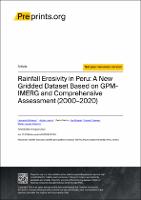Rainfall Erosivity in Peru: A New Gridded Dataset Based on GPMIMERG and Comprehensive Assessment (2000–2020)
Autor(es)
Fecha
2023Colecciones
Resumen
In soil erosion estimation models, the variable with the greatest impact is rainfall erosivity (RE), which is the measurement of precipitation energy and its potential capacity to cause erosion, and erosivity density (ED), which relates RE to precipitation. The RE requires high temporal resolution records for its estimation. However, due to the limited observed information and the increasing availability of rainfall estimates based on remote sensing, recent research has shown the usefulness of using observed-corrected satellite data for RE estimation. This study evaluates the performance of a new gridded dataset of RE and ED in Peru (PISCO_reed) by merging data from the IMERG v06 product, through a new calibration approach with hourly records of automatic weather stations, during the period of 2000-2020. By using this method, a correlation of 0.7 was found between the PISCO_reed and RE obtained by the observed data. An average annual RE for Peru of 4831 M Jmmha−1h −1 was estimated with a general increase towards the lowland Amazon regions and high values are found on the north-coast Pacific area of Peru. The spatial identification of the most risk areas of erosion, was carried out through a relationship between the ED and rainfall. Both erosivity data sets will allow us to expand our fundamental understanding and quantify soil erosion with greater precision.







